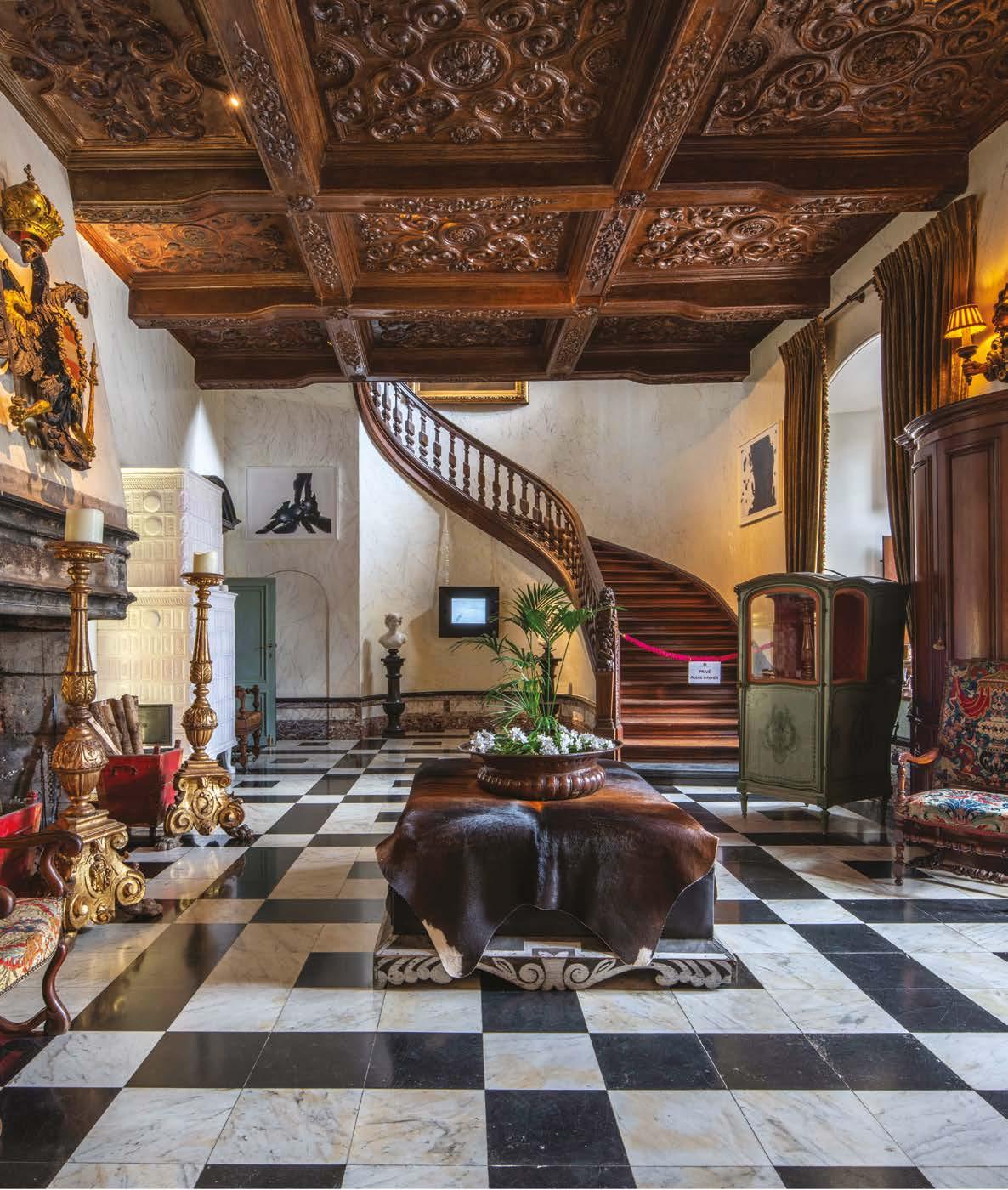
18 minute read
Castles in the Benelux
Photo: Château de Vianden
A fairytale destination CASTLES IN THE BENELUX
With its fascinating history, stunning countryside and regal châteaux, the Benelux is home to some of Europe’s most fairytale-like landscapes. This month, we step inside some of the region’s most breathtaking castles.
Photo: Thermae Boetfort
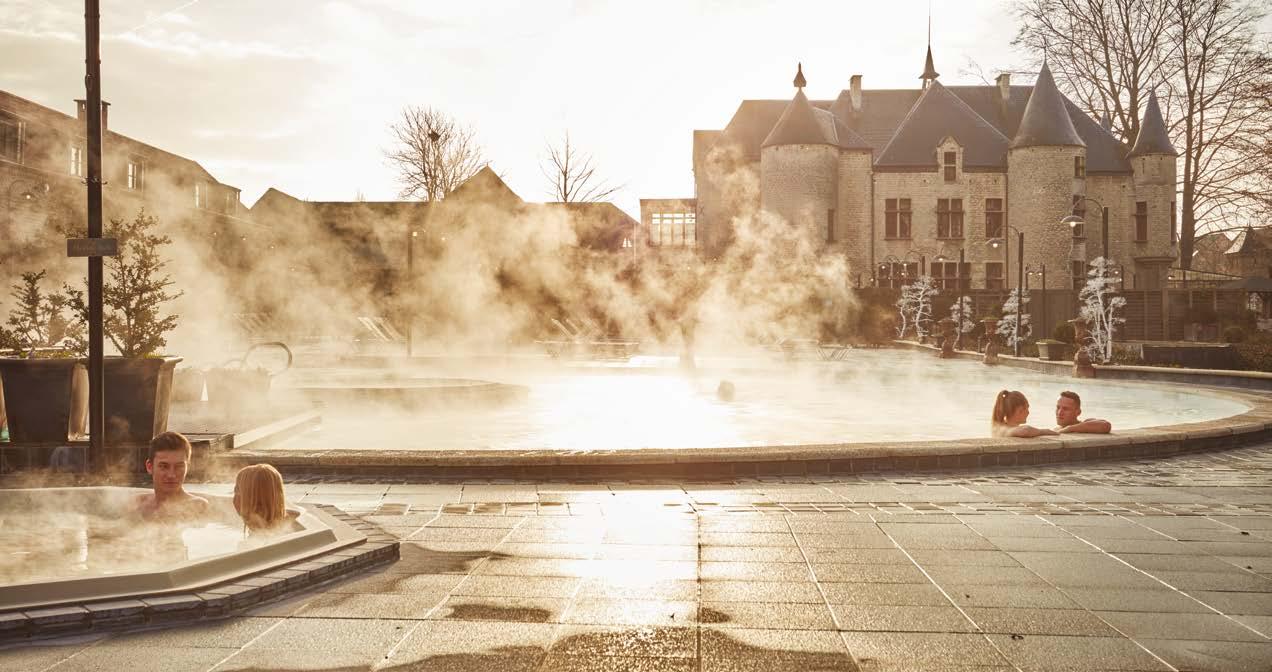
Photo: Château de Vianden
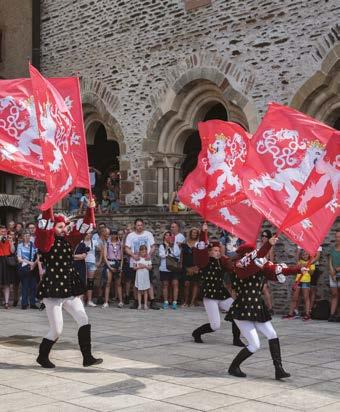
Belgium is a castle lover’s paradise. In fact, it is home to more castles per square mile than anywhere else in the world. Located in a beautiful region, world-famous for its beer, Château de Chimay is one of our favourites. A haven for culture vultures, the castle even boasts its own theatre and serves up an inspiring cultural agenda.
If pampering is your thing, another absolute must in Belgium is the Thermae Boetfort spa complex, which is housed in the grounds of the beautiful 17th-century Boetfort castle, which still features original tapestries and decorations.
Meanwhile, the Grand Duchy is home to more than 50 castles, many of which have been restored to their former glory. There, you can discover Luxembourg’s rich history and step back in time to the Middle Ages, with many castles hosting charming medieval festivals, unmissable exhibitions and world-class concerts.
Located in the north of Luxembourg, Vianden Castle has to be on your to-do list. Set on a rocky promontory, overlooking the town of Vianden and the River Our, it is one of the largest fortified castles west of the Rhine. Another must-see is the 12th-century Useldange Castle in western Luxembourg. Set high up on a hill, only 15 minutes from the Belgian border, above the village of Useldange, the castle is renowned for its ‘culture trail’ – a 16-stop journey through the history of the castle and its surroundings, as well as an exploration of life in the Middle Ages.
Château d’Useldange. Photo: Thierry Deutsch
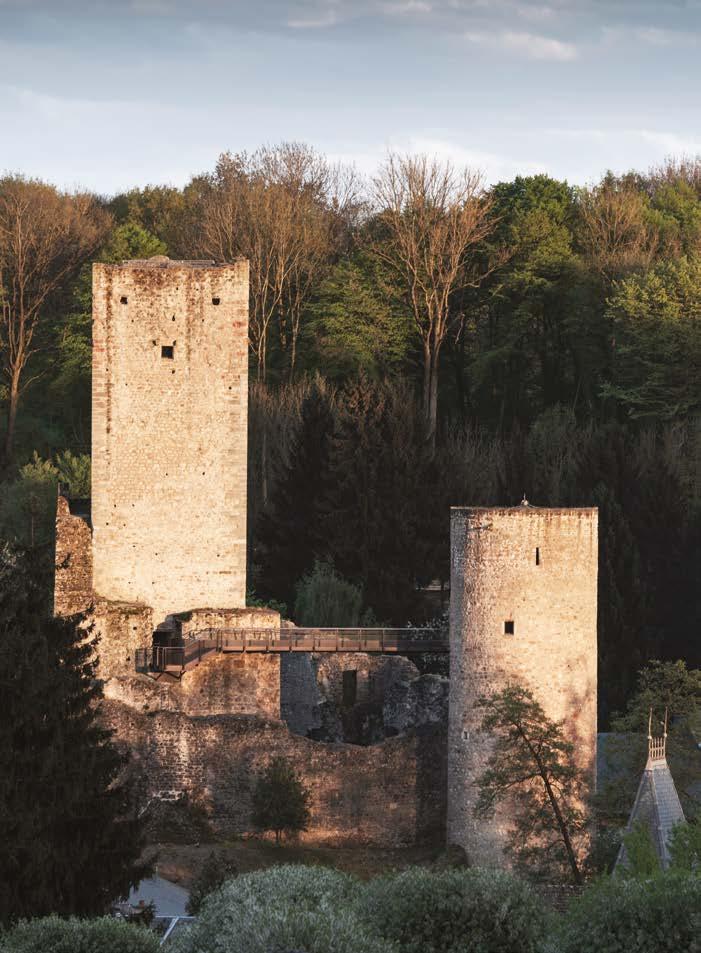
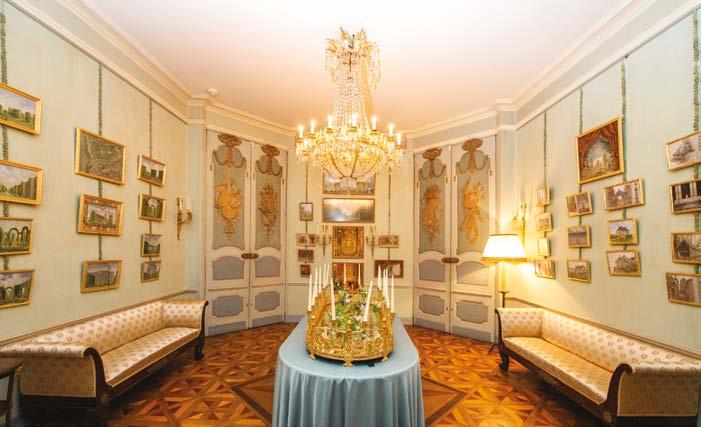
Take a trip to the Middle Ages at Vianden Castle
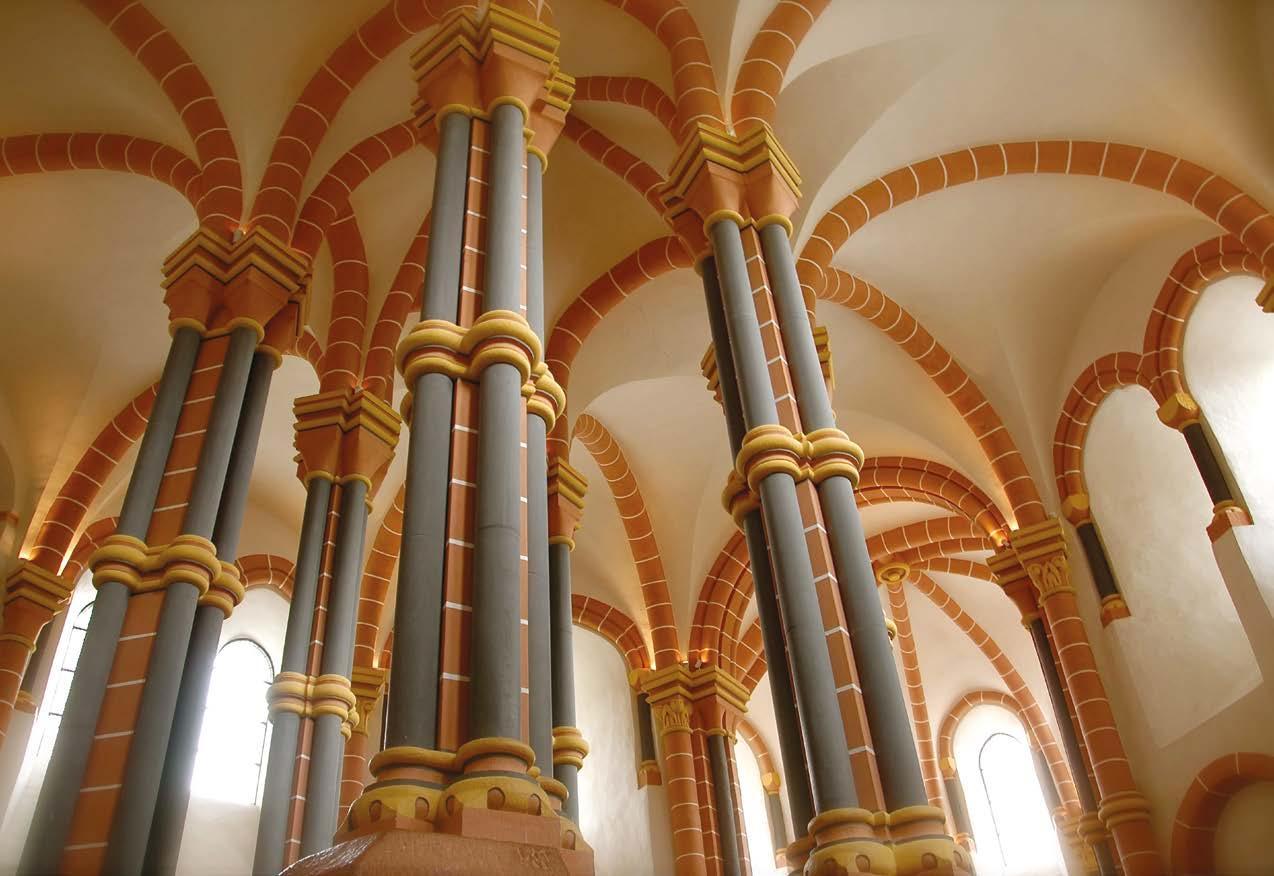
TEXT: ELODIE NOËL | PHOTOS: VIANDEN CASTLE
Built more than a thousand years ago, this Luxembourgish fortress has undergone some major renovations to bring it back to its original magnificent state. It is now considered one of the 21 most beautiful castles in the world ( CNN).
Located in the north of Luxembourg, Vianden Castle is a witness to history. One of the largest fortified castles west of the Rhine, it is set on a rocky promontory, overlooking the town of Vianden and the River Our. With a long and tumultuous past, the fortress has recently been fully restored and now attracts visitors keen to learn about its history. “The castle is almost a thousand years old,” explains Jessica Ersfeld, chief of staff at Vianden Castle. “It was constructed between the 11th and 14th centuries on the foundations of a Roman castellum and combines the Romanesque and Gothic styles. During the Renaissance, the castle went through great changes, with some renovations and new rooms being built.”
In 1820, under the reign of King William I of Holland, the castle was acquired through auction by a businessman who then sold it piece by piece. As a result, it fell into a state of ruin. In 1827, William II bought back the ruin. In 1977, its last owner, Grand Duke Jean of Luxembourg, sold it to the Luxembourg State, and then the reconstruction started. Since restored to its former glory, the castle now ranks as a monument of not only regional but European importance. “It was difficult to reconstruct the castle identically because we do not have photographs, but we do have a copper image dating from 1643 providing evidence of its original appearance,” says Jessica Ersfeld. “There have also been excavations that provided more
What not to miss With a total length of 90 metres, the castle is surrounded by a long and beautiful fortified wall hosting four gates, one of which had a drawbridge. Once you have passed the courtyard, its information centre and shop, the castle can tell you all its secrets. “20 rooms are open to visit, showcasing Romanesque, Gothic or Renaissance architecture. It’s a patchwork of different eras,” Jessica Ersfeld adds. Among the most notable parts, don’t miss the Upper chapel, dedicated to St. Anthony, which has been restored to reflect its original Gothic appearance, the Archaeological crypt, the Grand Kitchen or the two seigniorial lodgings. “We work in collaboration with the National Sites and Monuments Service, who takes care of the work that takes place perpetually in the castle.”
To help you make the most of your visit, audio guides are available in ten languag

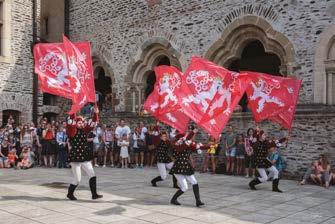
es. It is also possible to scan a QR code to obtain the audio guide on your smartphone. “On request, staff members can give guided tours of the castle, especially for groups.”
An international point of interest With such a rich history, it’s no wonder the number of visitors increases every year. “In 2018, we welcomed 190,000 visitors, and 219,280 in 2019. The Dutch represent nearly 30 per cent, followed by Luxembourgers, and then by neighbouring countries, French, Belgian and German. But visitors come from all over the world: China, Russia or even from New Zealand.” The castle welcomes families and has become a main attraction for children who come on school trips. “We are working on an interactive book about the history of the castle that will make it more accessible for children,” the expert adds.
What’s on at the castle? Alongside regular visitors, the castle regularly welcomes guests for historical, musical or even literary events, taking place throughout the year. “We organise numerous concerts during the year, mostly classical music. We have 18 already scheduled for 2020.” In June, Portae Temporis takes visitors back in time during a special weekend of activities, with stalls, craftsmen wearing period clothes and a lot of showcasing life in the Middle Ages. In July, the Medieval Festival is a nine-day event with daily entertainment: knights’ camp, demonstrations of sword fighting, musicians, fire-eaters, jugglers, entertainers, presentations of raptors and demonstrations of calligraphy. “The festival attracts about 30,000 people each year. You can find things to eat, the atmosphere is friendly and it’s very popular with families.” Vianden Castle also hosts the Book and Paper Festival in September.
The castle is open every day from 10am. For more info, visit: www.castle-vianden.lu

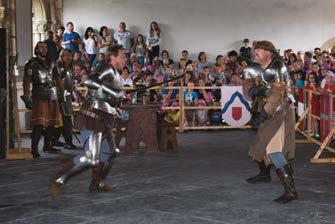
A taste of medieval life in Luxembourg
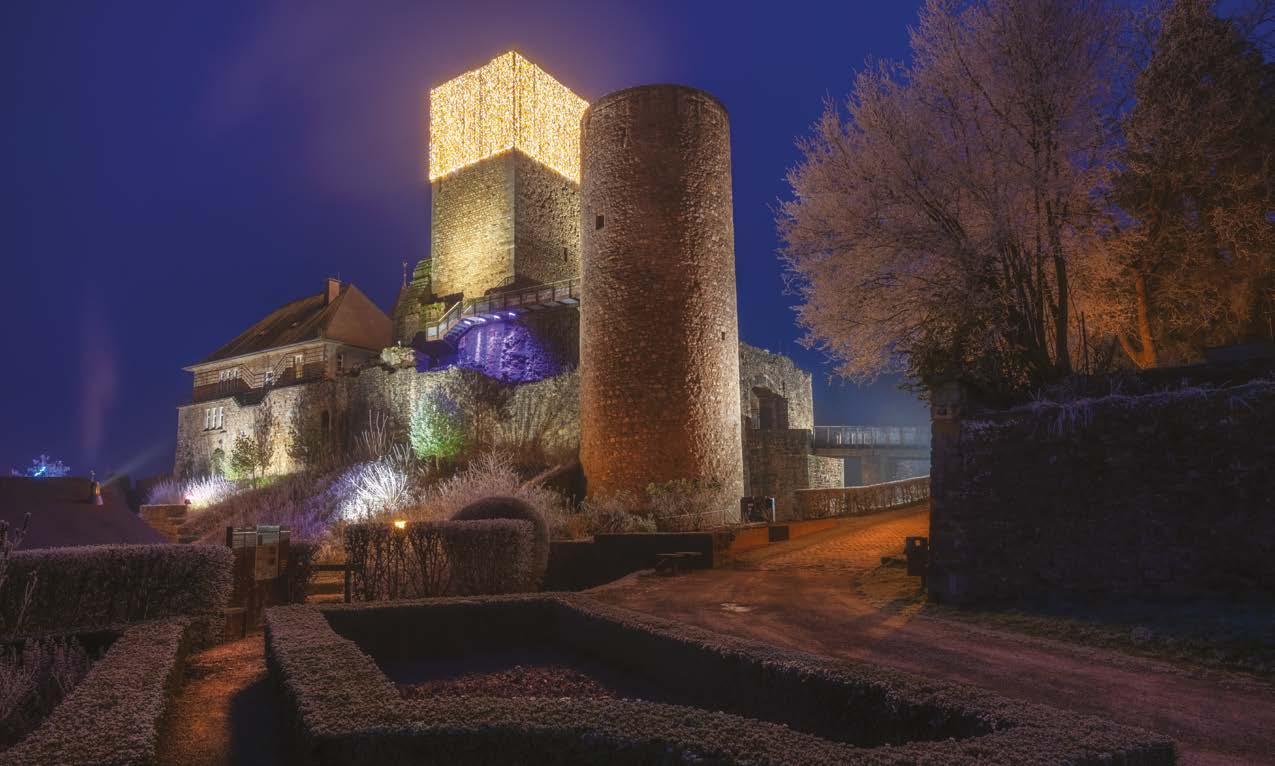
TEXT: EDDI FIEGEL | PHOTOS: THIERRY DEUTSCH
There’s nothing quite like standing in a medieval fortress to give you a real sense of life in the Middle Ages, and at the 12th-century Useldange Castle in western Luxembourg, you can do exactly that.
Walking along the vast fortress walls and climbing the two remaining towers – one round, one rectangular, the views alone are spectacular. Set high up on a hill, just 15 minutes from the Belgian border, above the village of Useldange, you can see the River Attert and its surrounding landscape for miles around and it was this high vantage point that was obviously what originally made the site so advantageous as a defence against hostile neighbours.
However, these days, Useldange Castle is most famous for what is known as its ‘culture trail’ – a 16-stop journey through the history of the castle and its surroundings, as well as an exploration of life in the Middle Ages.
Developed under the patronage of UNESCO, the trail has been specifically designed to work for all visitors, including those with visual impairments. Special provisions include information boards with explanations in braille lettering as well as audio presentations at every stage in English, French, German and Luxembourgish. two remarkable exhibitions are on permanent display.
In the first, the display traces the history of the fortress itself, spanning its origins in the ninth century through its evolution up until the 19th century, whilst the second tower focuses on daily life in the Middle Ages over the course of a year.
“For me,” begins Romain Kleer, president of Culture and Castle Friends Useldange, “it is the Culture Trail which makes Useldange Castle unique in Europe.”
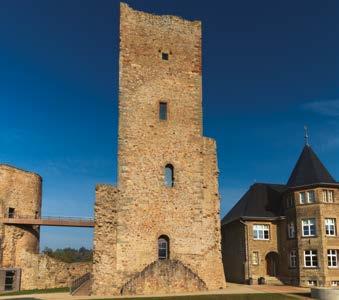
The first stop on the trail is the spacious underground crypt with a touchable model of the fortress itself. The trail then continues across the castle’s towers, where
The second exhibition is spread over the tower’s four floors with 3D panels and pictures exploring every aspect of life across the different seasons of the year, taking in the daily activities of people from all walks of life, from peasants to merchants, clergymen and nobles.
Gardens The trail then continues into the castle’s expansive gardens which include medieval gardens, a kitchen garden and a herb garden, as well as a stop alongside the river where you can see different species of fish.
Other stops include explanations of the various species of birds found amongst the castle’s grounds, as well as cartography, poetry, the chapel and the cemetery.
Annual Medieval Fair – 13 and 14 June, 2020 Alongside its ‘Culture Trail’ and grounds, castle Useldange Castle has also become renowned for its annual Medieval Fair, with two days of medieval-themed merriment.
Participants and indeed many visitors alike, dress in medieval costumes, whilst food tents sell themed food and drink – from ale to suckling pig and traditional local sausages. There are also craft stalls and musicians in traditional dress playing authentic early music instruments, falconry displays, fireworks and children’s shows.
The castle has welcomed some 5,000 visitors from France, Belgium, Germany,
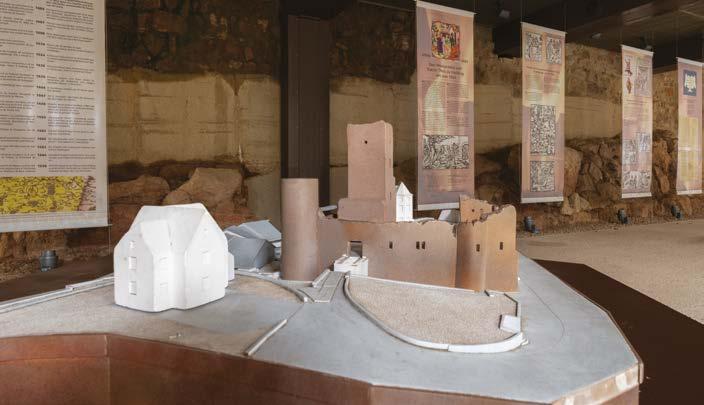
Photo: Administration communale d’Useldange
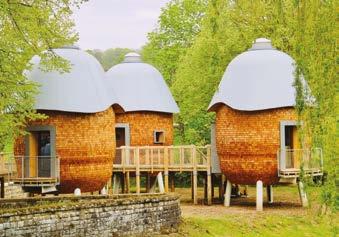
Luxembourg and beyond, and this year’s Fair on June 13 and 14 looks set to be even more successful.
Events and Workshops The Medieval Fair may be one of the highlights of the castle’s calendar but throughout the year, a series of events is organised at ManuKultura, a centre for art and culture next to the castle, including yoga and dance sessions, as well as sustainable upcycling courses, classes
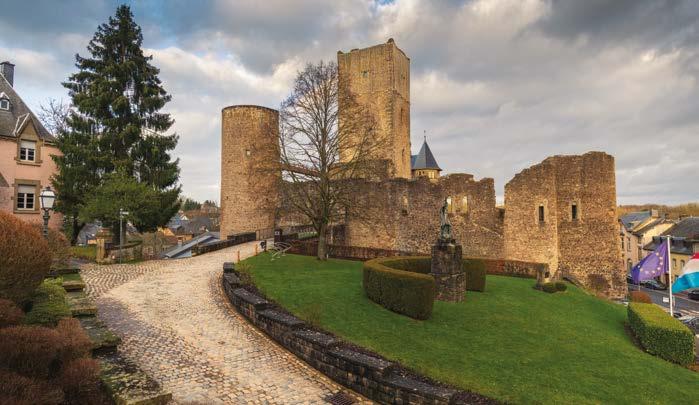
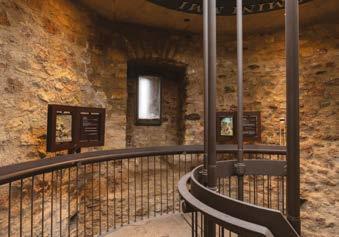
in calligraphy, genealogy and occasional blues music soirées.
Hotel and Restaurant Visitors who wish to really soak up the local atmosphere and extend their stay can also take advantage of the eco-friendly rooms at the Péitche Lauer Eco Lodges and Hotel. On the edge of the River Attert, there are nine rooms within the hotel itself or there’s the option of mushroom-shaped individual lodges, or ‘MushRooms’, as they’re known.
At the Péitche Lauer Brasserie, meanwhile, chef Raul serves up a daily changing seasonal menu with dishes such as veal Cordon Bleu, tagliatelle with two types of salmon, or ‘surf and turf’ with beef fillet and giant prawns with garlic sauce. There are also vegetarian and gluten-free dishes, as well as a children’s menu.
To book a guided tour, contact Visit Guttland: www.visitguttland.lu Tel: +352 28 22 78 62 Email: info@visitguttland.lu
Relax with a castle in the background at Thermae Boetfort.

THERMAE BOETFORT
Where wellness meets heritage
TEXT: MAYA WITTERS | PHOTOS: THERMAE BOETFORT
Whether you need something to warm you during the cold winter months, are looking for that perfect Valentine’s date spot, or simply want to soak up the health benefits of a trip to the sauna: Thermae Boetfort has you covered. This spa complex boasts all of the features you could possibly wish for in a wellness centre, plus a unique location: the grounds of a 400-year-old castle. “We want wellness to be accessible for everyone.”
Visitors to Thermae Boetfort get a free dose of culture served up with their wellness trip: inevitable, given its prime location in the 17th-century Boetfort castle. “The treatment centre and restaurant are located within the castle, which still features original tapestries and decorations,” explains marketing manager Ellen Van De Wijgaert. “The other wellness facilities are in the castle gardens and adjacent buildings. Wherever you are, a spectacular view is guaranteed.”
Wellness for everyone The health benefits of wellness treatments are well-publicised, and Van De Wijgaert believes that everyone should have access to them. “Warming up in a sauna and subsequently cooling down promotes a healthy blood flow and boosts your immunity – something we can all use in winter,” she explains.
“Seasoned sauna visitors usually go nude, but we also want the benefits of wellness to be accessible for those who, for whatever reason, do not feel comfortable with public nudity. That’s why we have two completely separate wellness areas, one where bathing suits are mandatory and one where they are not allowed. That way, everyone can enjoy the various saunas, pools and steam rooms in comfort.”
Whichever area visitors choose, they will be able to attend a host of additional experiences, all of which are included in the entry ticket. “We offer Aufguss sessions, scrub sessions, guided meditations with sound bowls, hammam rituals, halotherapy and more,” attests Van De Wijgaert. “All of these are aimed at helping our visitors relax and de-stress. People have such busy lives today; it is really important to

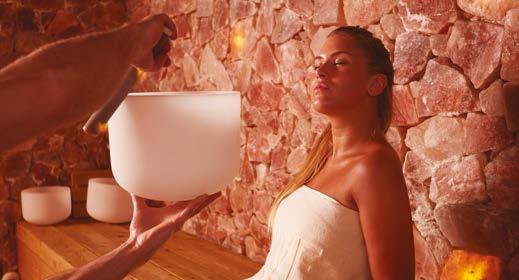
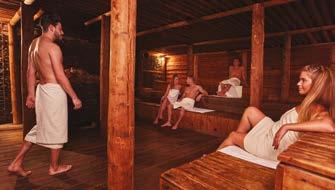
tend to our physical and mental wellness and to charge our batteries every so often.”
Room for romance Spa centres are of course a popular date spot, and Thermae Boetfort is no exception. The wellness centre happily caters to couples with a variety of arrangements, including the option to rent one of two private sauna suites. “Our private suites both include a pool, Jacuzzi, sauna and steam room, all completely private. While these are popular with couples, one suite can accommodate up to eight people and the other up to 12, so they can be rented out by groups, as well.”
The private saunas are especially in demand around Valentine’s Day, but couples who have missed the opportuni
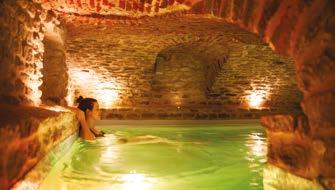
ty to book a private wellness slot still have plenty of other options to choose from. “We also run a hotel, with some rooms in a building on the castle grounds and some across the street,” explains Van De Wijgaert. “We offer special Valentine’s arrangements that include spa access and an overnight stay, as well as single day packages with some treatments included.”
Spotlight on sustainability Running a wellness centre inevitably requires a lot of electricity and water, but Thermae Boetfort makes a conscious contribution to sustainability wherever possible. “We have just transitioned to a PET-free operation: single-use plastics are banned from the site entirely. We offer reusable drink bottles at a low price and our customers can fill them throughout the
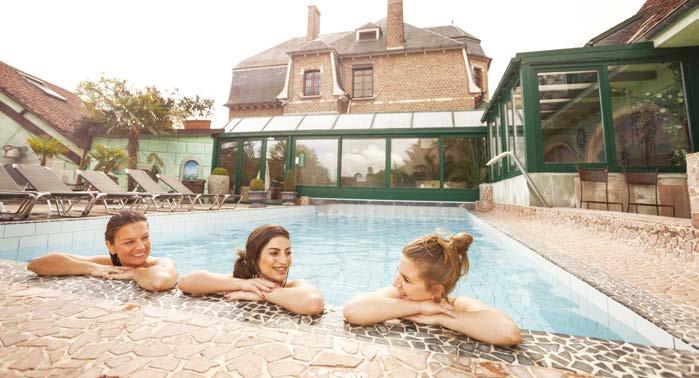

premises. We also use LED-lighting everywhere to reduce our carbon footprint.”
The Boetfort premises also boast a restaurant within the castle, where hungry visitors can revive over anything from small snacks and daily specials to extensive dining menus, all cooked on the spot. The kitchen caters to all diets and preferences, whether you’re after a healthy meal, a filling pasta or even a glass of the spa’s very own Boetfort beer.
In addition to its top-notch facilities and décor, Thermae Boetfort is ideally located a stone’s throw from Brussels Airport, allowing weary travellers to make a pit stop before or after an exhausting flight. “We are open until midnight every day, so those with late flights can come and rest up before their departure,” concludes Van De Wijgaert.
Thermae Boetfort is open every day of the year apart from Christmas Day, from 10.30am to 12am. Its sister location Thermae Grimbergen offers a similar wellness experience in a peaceful, green setting.
Thermae Boetfort, Sellaerstraat 42, 1820 Melsbroek. For more information, visit: www.thermae.com
Château de Chimay.

CHÂTEAU DE CHIMAY
Home of legends and life stories
TEXT: NATHALIE MARCHAL AND ANNA VILLELEGER | PHOTOS: PHILIPPE LOISON
Glorious memories, erstwhile glory, curiosity and fascination… the Château de Chimay intrigues, surprises and marvels everyone from history fanatics and students, to connoisseurs and music lovers.
With over 20,000 visitors per annum, the Château de Chimay has the privileged feeling of being the place to be, with a full and ambitious agenda.
All for music Built during the 11th century, the granite fortress became an Imperial château in the 1480s. Over the centuries, through the torments of history and numerous rebounds, Chimay has played a remarkable role on Belgium’s cultural and heritage scene, and continues to do so today.
Probably as something of a sign of destiny, artists and music aficionados have forever been meeting at Chimay to perform or to work in residence there. The Château still resonates in the music world today, with the numerous concerts regularly held in its astonishing 19thcentury theatre.
This is a magical place where exceptional moments happen… and the 2020 season will once again bring further excellence.
Quiet! Action! During visits to the Château, inside the magnificent theatre, guests have the privilege to hear from a delightful story teller, who is passionate about royal and princely families. Who could it be? You may have guessed – it is Stéphane Bern, recounting the Secrets of Chimay. A fascinating journey through Chimay’s remarkable history Keen to find out more about the Secrets of Chimay with Stéphane Bern, we spoke to Vanessa Pontet, director of the fasci
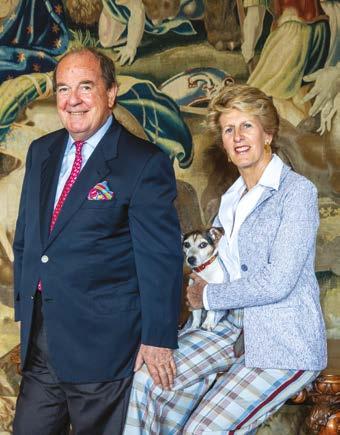
The unreleased and exclusive film sets the scene for this never-ceasing-to-inspire location. Prince Philippe and Princess Françoise continue tradition with their subtle and effortless work, and Chimay shines once again in its current era.
nating film. The expert is a director of documentaries and docudramas, specialising in the history of Europe’s castles. Her work includes La guerre des trônes, la véritable histoire de l’Europe (War of Thrones, The Real History of Europe ) on France 5, as well as Secrets d’Histoire (Secrets of History) presented by the renowned royalty and nobility expert Stéphane Bern on the television channel France 2.
The incredible story of Madame Tallien In fact, it was during the making of Secrets of History that the film Secrets of Chimay came about. “Four years ago I was working on Secrets d’Histoire ( Secrets of History), presented by Stéphane Bern. I made one episode called Les femmes de la Révolution (The Women of the Revolution ), where we told the female stories behind the French Revolution,” she begins. “One of the women we talked about was the French noblewoman Madame Tallien, who was a Revolutionary muse during the period of Robespierre, but later went on to become the Princess of Chimay through her marriage to François-Joseph-Philippe de Riquet, Comte de Caraman in 1805. It’s an incredible story.”
It was during the making of Secrets of History that Vanessa met Prince Philippe and Princess Françoise, and they approached her about making a film to present the castle. “I get on so well with the Prince and Princess, and I absolutely love the castle, so I was absolutely over the moon to be asked,” recalls Vanessa.
Tumultuous times Estimated to be more than a thousand years old, Chimay is one of the few castles still lived in by its owners, and first opened to the general public soon after the Second World War. Families have succeeded each other throughout the castle’s most painful times, surviving wars, political disruption, looting and fires. Over the centuries, nine families have passed the castle and its land from one generation to the next, most significantly the Soissons, the Hainauts, the Croÿs, the d’Arenbergs and, of course, the Chimays.
The weapons room.
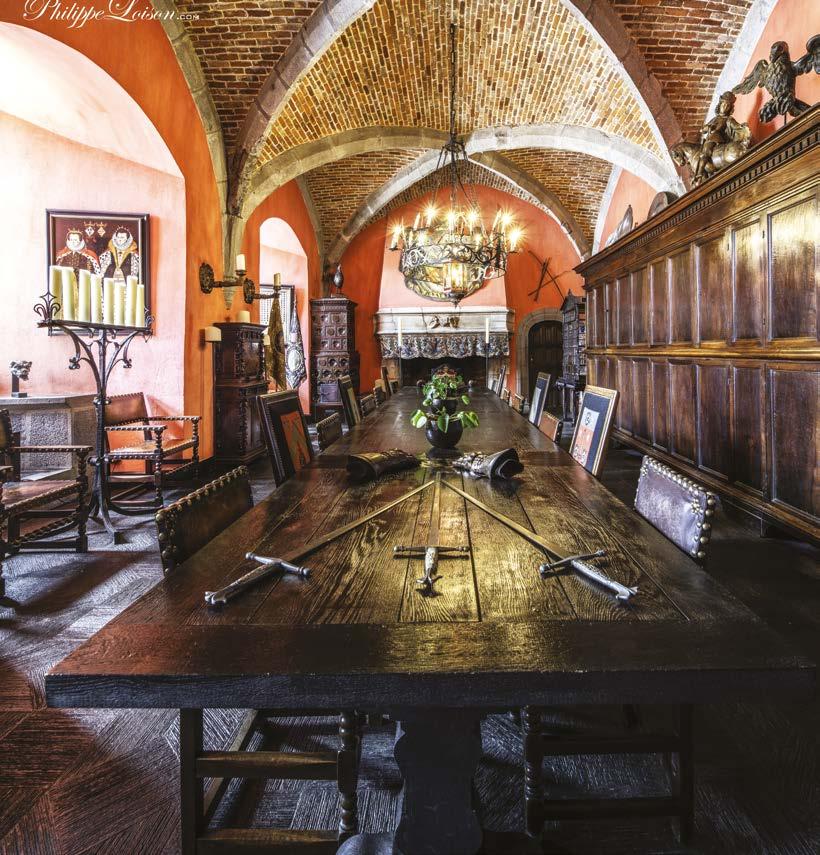
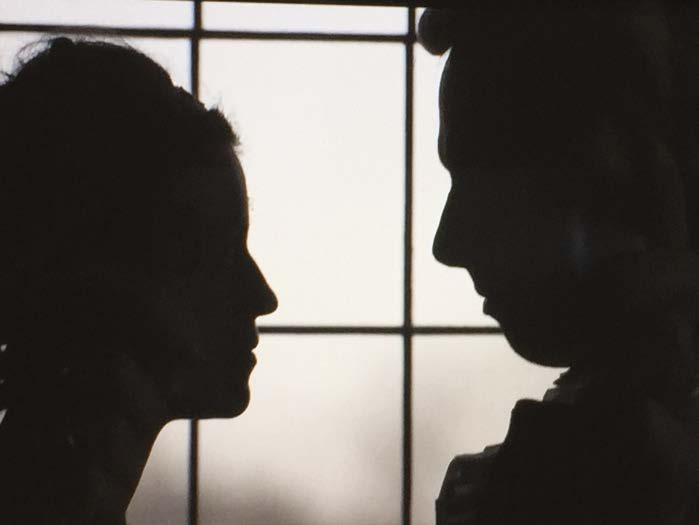
The theatre.


The Thierry Bosquet salon. Photo: Tanguy Stichelmans
Leading historians Presented by Stéphane Bern, Secrets of Chimay sees actors re-enacting key moments and portraying important figures in Chimay’s history. The film also includes input from an array of renowned names including historical journalist and writer Franck Ferrand, historian Catherine ErmaryVieille, writer Marie Cornaz, and writer and historian Laure Hillerin. Also featured are Mathieu Da Vinha, scientific director of the Palace of Versailles Research Centre, not to mention Princess Françoise.
“Making this film was a beautiful experience,” smiles Vanessa, explaining how the film was shot on location, with Stéphane Bern and all the actors coming to the castle. “It is extremely rare for all the filming to be done on location, and it made the film even more special.”
Palace of Versailles Vanessa points out that the support of the Palace of Versailles was also greatly appreciated in the making of the film. “The management of Versailles agreed to open the doors of the Petit Trianon, the small château located on the grounds of the Palace of Versailles,” she reveals. In fact, Versailles is still today home to the Chimay Attic, which is a reminder of the sumptuous apartments of Laure-Auguste de Fitz-James, Princess of Chimay, a lady-in-waiting to Queen Marie Antoinette from 1770 to 1791.
A magnificent setting During the 30-minute film, visitors are taken on an incredible tour of all the major stages in the castle’s history. Visitors watch the film in the castle’s breathtaking theatre, which was modelled on the Louis XV theatre in Fontainebleau. Seating 130 guests, the theatre was entirely rebuilt in 1863 and since then has been refurbished and upgraded in a continued effort to keep it authentic yet modern. “It is a magnificent setting, just beautiful!” concludes Vanessa.
Château de Chimay Rue du Château 14 / 6460 Chimay Tel: +32 60 21 45 31 www.chateaudechimay.be
